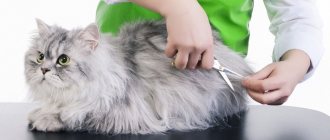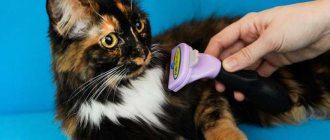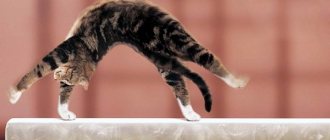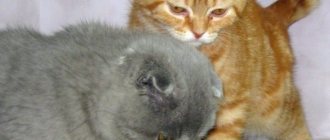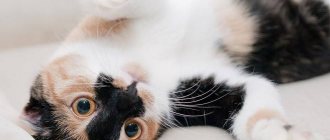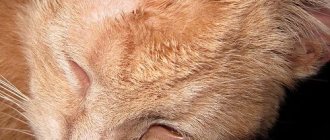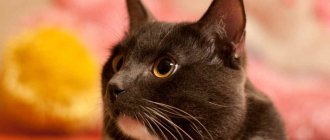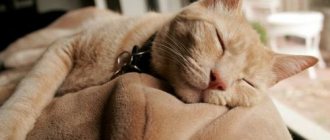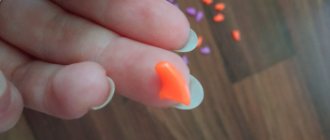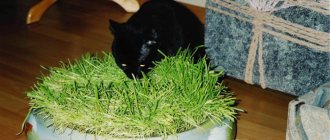Under natural conditions, animals quietly get rid of keratinized particles in the process of moving on hard surfaces, while climbing trees, hunting, etc. At home, pets do not have this opportunity, therefore, if the cat is not accustomed to a scratching post, furniture, etc., are used. walls, carpets.
Do not rush to punish the fluffy - just carry out hygienic trimming of the claws. It is performed using a special tool - a nail clipper. You can find several types of this device in pet stores.
Why do you need to do a cat manicure?
Cats' claws invariably grow, and they need to be tidied up - trimmed using a special nail clipper. Overgrown claws can cause discomfort to the animal or cause injury.
In nature, cats walk on hard surfaces or wear down their claws on trees and other convenient objects. At home, animals are deprived of this opportunity and cannot do without human help. Therefore, from time to time they need the so-called cat “manicure”.
Overgrown claws can become ingrown or cause discomfort when walking. The cat may also get caught in a carpet loop or some piece of furniture, which will lead to a finger injury and medical intervention.
When their claws grow long enough, cats begin to grind them down themselves. In the best case – on a scratching post, in the worst – on wallpaper or furniture. Timely manicure is the key to the cat’s health and the integrity of the owner’s sofa.
What is a claw cutter
People use nail scissors to take care of their nails. And for cats there is a special accessory - a nail clipper. It differs from nail scissors both visually and functionally. The appearance of a nail clipper depends on the type, although they are all roughly similar. Only the electric nail grinder is radically different.
Description of the tool
There are four types of cat nail clippers. Each one has its own individual appearance and nuances of working with it.
In a veterinary pharmacy or pet store, you will immediately recognize nail cutters: these are small pruning scissors, the blades of which have a recess for the claw. Well, the grinder looks like a plastic handle with a small rod that rotates at high speed and grinds down the claw.
It is optimal to choose a tool with a handle that is comfortable for you: it fits in size, does not slip, and does not squeeze your fingers. The blades must be serrated, sharp, smooth and shiny.
Why regular manicure accessories are not suitable
A human nail and a cat's claw have different structures and densities, which is why different care products are selected. The nail is a plate that does not itself have nerve endings and blood vessels, so when cutting, only the skin and tissue of the finger can be damaged.
The cat's claw has a hollow structure and a crescent-shaped curve. It contains blood vessels and nerve endings that are very easy to damage, causing pain and bleeding. It is much easier to injure a cat with ordinary scissors than with a nail clipper.
Another caveat: human scissors or wire cutters tear apart a cat’s claw, which leads to problems ranging from crumbling to bleeding or ingrown nails. The nail cutter cuts the plate more evenly and sharply, so the claw does not peel off.
Before you begin the nail trimming process, it is important to familiarize yourself with the basic anatomy of a cat's claw and paw and learn how to correctly determine the length that needs to be left.
Haircutting tools
First of all, to successfully perform a cat manicure, you need to acquire a tool. In specialized pet stores and veterinary pharmacies you can find all the equipment necessary for the procedure:
Nail clipper-scissors. In appearance it resembles ordinary nail scissors, but with notches on the blade. It is in these grooves that it is convenient to insert a cat's claw so that it does not slip. The device allows you to quickly and evenly shorten claws.
Trimmer in the form of a guillotine. The tool resembles pliers with a ring instead of blades. The trimmer is easy to use and very popular among experienced owners. Beginning cat breeders may have difficulty determining the length of the claw to cut.
Nail clipper. The device is safe to use, as it has a locking system that prevents the blades from closing.
Veterinary clinics and animal care salons use electric nail clippers, which are classified as professional tools.
Tools for cutting claws With a wide selection of cutting devices, the owner is often at a loss as to how to trim a cat’s claws. If you have little experience in this procedure, then you should choose a nail clipper or scissors. The choice of tool also depends on the condition of your pet’s claws. If they are thin and transparent, then scissors or pliers will do the job, but if the claws are dense and thick, then a guillotine trimmer will be the best option.
At home, you can also use nail scissors or clippers to perform the procedure. In addition to the cutting tool, you will also need a hard nail file or emery block for correction after trimming. Just in case, you need to arm yourself with cotton swabs and 3% hydrogen peroxide.
Types of devices
There are variations of nail clippers of different types, models, shapes and designs. There are some that are very easy to use - they are suitable for novice cat owners, and there are special ones designed for professional breeders and groomers.
Before going to the store, it is better to find out what the differences are between the main types of nail clippers, as well as their advantages and disadvantages.
Guillotine
This type of tool consists of two working parts: movable and fixed. Trimming is performed by a moving part, which is installed perpendicular to the claw placed in a special hole. The use of guillotine claw clippers requires certain skills, since when fixing the nail plate it is not visible. However, despite this disadvantage, guillotine-type tools are very popular - especially among owners of large cats with hard claws.
Scissor nail clipper
Scissors are the simplest solution. Outwardly, they resemble human manicures, only with rounded blades and a hole in the middle. It is intended for laying the claw and fixing it during the procedure.
The tool is very easy to use: you place a cat's claw in the notch, the handles close together, and the result is a neat, smooth cut. Suitable for small cats and kittens.
Nail clipper-secateurs
Resembles regular wire cutters or needle nose pliers. The handles have rubber linings, fit comfortably in the hand and do not slip. The spring included in the mechanism also makes working with the accessory easier. The cut is better than that of scissors.
Most models are equipped with a special limiter that sets a certain length and protects against cutting off excess. A special safety lock blocks the cutting surfaces when the pliers are not in use. There are straight and curved models on the pet products market.
Electric nail clipper or grinder
This is a power tool, so it is the most functional and expensive. During operation, the grinder head with an abrasive coating rotates and grinds down the claw plate like a nail file. The device comes with various attachments and limiters.
A beginner without the skill of working with an electric grinder can easily injure a pet by affecting the living part of the claw. Such devices are more often used in professional grooming salons. In stores you can find models that operate on mains power, batteries, and rechargeable batteries.
Choosing a nail clipper
It is necessary to choose a nail clipper based on the physical characteristics of your pet, because there are very small products, for example, suitable exclusively for kittens. And if you have an adult Maine Coon, cutting his nails with such a tool will be inconvenient.
It is better to accustom cats to trim their claws from a very early age, then an adult animal will not have problems with this.
Device size
There are three main sizes - extra small, medium and large. Very small ones made for kittens. Medium ones are suitable for almost all cats, except for the largest specimens. Large ones are, as a rule, nail clippers for dogs, which, however, can also be used for cats.
There is an opinion that it is necessary to evaluate the thickness of an animal’s claw, but you will not find an indicator of the maximum thickness or anything similar on any product. So you need to focus on ease of use.
The choice of nail clipper size is purely individual. Some owners find it more convenient to use large products, while others find it more convenient to use small ones. However, a universal option are medium-sized nail clippers, which are usually labeled “cat-shaped.”
Tool material
The material of the spring mechanisms and the blades themselves are metals, mainly steel and stainless steel.
The handle material is plastic, sometimes with rubberized inserts for better grip in the hand.
When choosing a nail clipper, it is better to focus on its mechanism, ease of use and dimensions than on the materials, which are mostly the same in all products, at least in their names.
Nail clipper scissors are easy to use due to their form factor and are relatively inexpensive
Manufacturer
Among the manufacturers producing mass budget products, you can pay attention to the brands Trixie, Ferplast, Pedi Paws, CaniAMici - they produce a wide variety of products for pets at a good level.
Brands such as Andis, Wahl, Oster - they specialize specifically in haircutting devices, so their products belong to a more premium segment, cost 3-4 times more, however, the sensations when using will be somewhat different - smoother operation of the device, sharper blades, more tactilely pleasant materials.
How to choose a nail clipper for cats
It’s best to choose a nail clipper for cats this way: whichever tool is convenient for the owner, that’s what you should buy. If the nail cutter fits well in your hand, misfires and injuries will be reduced to almost zero.
The second important point is the size of the cat and, accordingly, the size of its claws. For thin and transparent claws, on which the vessels are clearly visible, you can use scissors or nippers. If the claws are thick and large, you must use a guillotine or grinder.
The tool must be of high quality, and its blades must be dense and made of good steel. The nail clipper should not seem too light or heavy to the owner, as this can cause inconvenience and awkward movements during cutting.
Using a nail clipper
A nail clipper should be beneficial for cats and their owners, eliminating harm and stress. To do this, the owner must be fully prepared for the procedure himself. The cat needs to be reassured and ensured that it is feeling well.
Nail trimming procedure
Before starting the procedure, you must wash your hands, your pet’s paws, and also disinfect the nail clipper itself. Next, proceed according to the steps:
- The cat should be calm. If there are signs of illness, it is better to postpone the procedure until better times. You should not cut the nails of an animal that has just eaten or is scared - it may vomit. If the cat gets nervous and struggles, it will jerk its paw and damage a claw or finger.
- It is better to pick up the cat, calmly talk to it and stroke it. This will make her more comfortable. At this point you can begin the procedure.
- The nail cutter is taken in the hand so that it fits comfortably and tightly, and it is easy for the person to control all movements. It is better to take the paw in such a way as not to pinch your fingers and not cause discomfort to the cat, acting gently but confidently.
- To make the claws clearly visible, you need to gently press the pad on the paw in the very center: the claw will come out slightly.
- Next, it is important to determine where the capillaries and nerve endings are located in the nail. To do this, you need to look at the claw in good lighting: this part will be pink. In black cats it may be brownish.
- You can cut off the entire transparent part of the claw, just short of the pink part.
It is better to file the edge with a file or buff so that there are no rough edges or nicks left.
Precautions and possible injuries
It is important to carry out the procedure cleanly and in good lighting so that the “living” part of the claw can be seen. If it is damaged, blood may bleed and the cat will be in pain, so you need to retreat 2-4 millimeters from this place.
In case of severe bleeding, immediately apply a tight bandage and, without wasting time, contact your veterinarian. Mild bleeding can be stopped with hydrogen peroxide.
If your cat has an ingrown claw, you should not try to deal with this problem on your own - it is better to immediately contact a specialist. A good grooming salon or any veterinary clinic will eliminate this nuisance.
Tool storage
A nail clipper can be classified as a pair of scissors or nippers. Due to the presence of blades, the tool is dangerous, even if it has a locking mechanism. It is better to keep it away from children and animals to avoid injuries and accidents.
The nail clipper does not require special storage conditions, but you should not place it with objects that could damage the blades. It is also recommended to keep it away from water and damp places.
Features of nail trimming
Claw trimming is a controversial procedure that causes a lot of controversy and debate among veterinarians and pet owners. Some argue that this is necessary, others believe that subjecting a cat to such executions is inhumane and makes no sense. In reality, each animal requires an individual approach. There are cases when trimming nails helps prevent the occurrence of pathologies and ensures full functioning.
A little anatomy
To understand the essence of the nail trimming procedure, you need to familiarize yourself with some anatomical features. The cat's toe has a specific structure: it consists of several phalanges (the last one ends in a claw), blood vessels, nerve endings, joints and muscles. The claw is tightened by a special tendon, which is located in the upper part of each finger. In a calm and relaxed state, the claws are hidden in the folds of the paws; in an excited state, they appear outside. The crescent shape of the claw allows the animal to tenaciously grab prey (literally “keep it on the hook”) and defend itself from enemies.
When a cat is in a relaxed state, its claw is hidden inside the folds
The visible part of the claw consists of two parts: “living” (the pulp, located at the base) and keratinized (the tip of the claw). The “living” area is replete with blood vessels and nerve endings, so any damage to it is accompanied by painful sensations for the cat. The stratum corneum is constantly renewed throughout life. By grinding its claws off on objects, the pet frees itself from the dead old cover (the owners have probably noticed more than once the claws left by the cat in the upholstery of upholstered furniture or a scratching post).
It is thanks to the tendon that the cat is able to retract and extend its claws
The essence of the hygienic procedure is to remove the stratum corneum without affecting the pulp. Otherwise, the animal will be injured and will need several days to recover. Also, we should not forget that trimming nails in any case gives the pet discomfort and unpleasant sensations, even if only dead areas are trimmed. This is due to the presence of nerve endings.
It is necessary to cut off only the top layer, departing from the pulp at least 2 mm
Disadvantages of the procedure
In addition to the unpleasant sensations, there is another compelling argument against. The fact is that claws are the main tool of the animal’s life: with their help, the pet climbs a tree or cabinet, defends itself, and gets food. After the hygiene procedure, the animal, out of habit, trying to climb to a height, may fall and get injured. Cats that are allowed outside by their owners are at particular risk because they cannot defend themselves if attacked by other animals.
When to trim nails
A hygienic procedure is necessary in the following cases:
- before mating and exhibition. In the first option, cutting is necessary so that the animal does not injure its partner; in the second, it is a mandatory requirement according to the competition regulations;
- in case of excessive growth of the stratum corneum. Typically, a similar problem occurs in Sphynx cats and Persian breeds. Due to a deficiency of vitamins D and B in the body, the horny part peels off. Untimely removal of the dead part leads to the fact that the pet clings to the pile of the carpet, sofas and, as a result, can either tear off a claw, damaging the “living” part, or accidentally dislocate its paw;
- when an animal, due to old age or illness, cannot sharpen its claws on its own. In this case, the procedure is necessary, since the claws can grow in different directions and painfully dig into the pads of the paws. An ingrown claw is a serious pathology when surgical intervention is inevitable. The animal cannot move independently due to severe pain, and the wound often bleeds.
Cats have a fifth, vestigial claw on their front paws. It is difficult for them to cling to something, so the stratum corneum here is much longer than on the other paws. The owner needs to control and trim the dead part in a timely manner so that the claw does not penetrate into the pad.
On a rudimentary claw (it is located separately from other fingers), the stratum corneum grows faster

